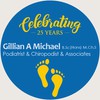
A Podiatrist is a medical specialist trained in the treatment of the lower limb. Podiatrists carry out all the treatments which are usually associated with Chiropodists, with the important difference that Podiatrists treat the entire lower limb (from the hip down) rather than just the foot.
This includes a large field termed "biomechanics", which is concerned with the alignment of the bones in the foot and the relationship between "misaligned" bony architecture and its resulting symptoms.For instance, if someones foot flattens excessively when they walk, the leg tends to twist inwards, putting excessive strain on the inside edge of the knee joint which can become painful.
This includes a large field termed "biomechanics", which is concerned with the alignment of the bones in the foot and the relationship between "misaligned" bony architecture and its resulting symptoms.For instance, if someones foot flattens excessively when they walk, the leg tends to twist inwards, putting excessive strain on the inside edge of the knee joint which can become painful.
Services
Our Qualifications
Report
State Registration was a mandatory requirement for employment within the National Health Service and also included a licence to administer local anaesthesia. In 2005 the State Registration system was replaced by a body called the Health Professions Council, and all Podiatrists must be registered with the H.P.C. in order to practise legally in the U.K.
Verrucae
Report
Verrucae are caused by the H.P.V. (Human Papilloma Virus) and are no different to warts found anywhere else on the body, with the exception that they tend to grow inwards if they are on the weight bearing surface of the foot, and therefore appear to have a flat top.
Although some verrucae are not painful (and may often go unnoticed for many months), some are extremely tender as they are effectively areas of swollen tissue which press on the nerve endings in the skin.The verruca virus speads through contact and is therefore often contracted in places where people go barefoot, such as swimming pools and gym changing rooms.
Although some verrucae are not painful (and may often go unnoticed for many months), some are extremely tender as they are effectively areas of swollen tissue which press on the nerve endings in the skin.The verruca virus speads through contact and is therefore often contracted in places where people go barefoot, such as swimming pools and gym changing rooms.
Corns & Callouses
Report
We advise against the use of corn removing plasters which are found in many chemist shops. These contain an acid which is intended to break down the corn and allow it be scraped off of the foot. However, the acid is often too strong for the corn and destroys not only the corn but the underlying tissues as well.
Ingrowing nails
Report
Ingrown nails occur most commonly on the big toe and are caused by either poor nail cutting technique, tight shoes, or just plain bad luck if you have wide or highly curved nails.
Nails can become painful along the sides if they curve downwards into the flesh of the toe or become excessively thick; when this happens there is often also a buildup of hard dry skin underneath the edge of the nail plate which may become painful, although this is technically an "involuted" nail rather than an "ingrowing nail".
Nails can become painful along the sides if they curve downwards into the flesh of the toe or become excessively thick; when this happens there is often also a buildup of hard dry skin underneath the edge of the nail plate which may become painful, although this is technically an "involuted" nail rather than an "ingrowing nail".
Sports injuries
Report
Prevention (of future injury). This is really common sense. For instance, if a particular pair of training shoes have caused a blister, or if an inadequate warm up has resulted in a muscle strain, make sure that you address the cause of the injury! Rest - most important and often neglected. If you exercise on an injury which has not healed up properly, it will simply make it worse and probably mean that you are out of action for longer.
Reviews

Be the first to review Chingford Podiatry Centre.
Write a Review


